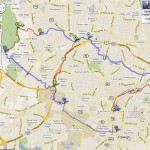There’s a lot at stake… First consider Sig Hutchinson’s dream for area walkers, runners and bikers:
Sig Hutchinson, co-founder of the Raleigh Downtowner has long been working to build 150 miles of greenway trails spanning Falls Lake to Durham’s American Tobacco complex, and he sites Crabtree Creek as the connection point for the rest of the grid. Sig says, “The (1.3 mile) Crabtree Creek Greenway connection to Umstead State Park is the final link in a hundred plus mile greenway system”.
The DLA also sees an advantage in this connection, since it allows downtown residents to not only walk, run or bike on greenways from Downtown to Umstead Park, but they’ll be able to continue through the park and connect through the new Crabtree Creek greenway onto Shelley Lake, or east past Raleigh Boulevard and all the way to New Bern Avenue. With plans for a future 3-mile link to Downtown from Raleigh Boulevard, residents will enjoy a continuous 26 mile loop.
So what is the problem?
This connection has been shown on greenway maps for years, but the city needs land for the easement, which runs through Hanson’s quarry. Now that the quarry seeks to expand, owners have proposed a trade. If the city allows them their request for expansion, then they agree to unlock this important greenway connection.
 Click the image to enlarge
Click the image to enlarge
This image shows how the future 1.3 mile Crabtree Creek greenway section would connect to the existing greenways through Umstead Park.
Consider the issues involved:A website blockthequarry.org promotes community opposition to the quarry expansion, and a recent article from the N&O, Raleigh quarry wants to grow, also outlines concerns.
“A mining company wants to extend an 80-year-old rock quarry that abuts an upscale neighborhood and Umstead State Park. But a group of North Raleigh residents is fighting the expansion, saying it could lead to environmental damage, noisy neighborhoods and diminished property values.”
Indyweek.com also talks about the issues involved – Raleigh quarry quandry, creek or greenway?.
Sig Hutchinson continues to fight for walkers and bikers through his Greenway ACTION Alert, asking residents to send a message to Raleigh City Council members regarding this “last piece in the Greenway System yet to be secured and the gateway connecting Raleigh to the rest of the region.” Sig says, “When I talk to groups interested in greenways, far and away the most important segue that people talk about is this connection at Crabtree Creek. And now the option for the quarry to expand creates a window of opportunity for the greenway. If this goes away, it’s just too easy for them to walk away and never open the door again.”
The Planning Commission Committee of the Whole is expected to decide on the issue at their scheduled meeting on Tuesday, February 1st (9-11am) at the Raleigh Municipal Building, Rm 303. The meeting is open to the public.
Where do you stand?
Come to the meeting so you can make your voice heard in this important decision for Raleigh’s development.







